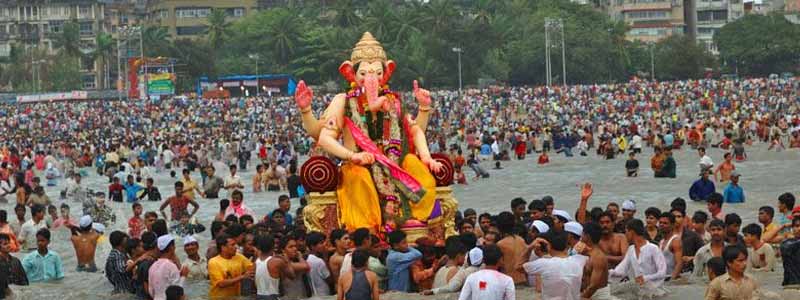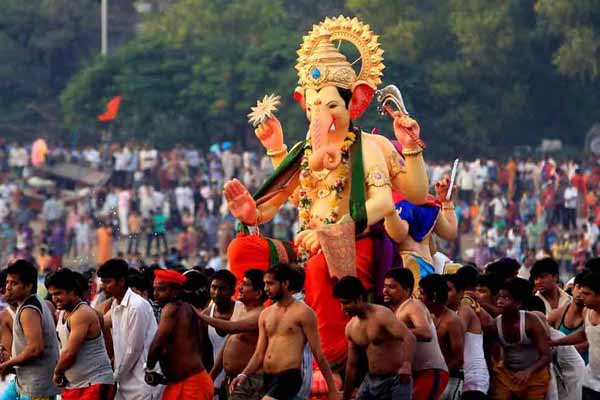Ganesh Chaturthi in Rajasthan, also known as Vinayaka Chaturthi, is celebrated with great fervor and enthusiasm in the state of Rajasthan, India. This auspicious Hindu festival marks the birth of Lord Ganesha, the elephant-headed God of wisdom, prosperity, and good fortune.
In Rajasthan, the festivities begin with devotees bringing home intricately crafted clay idols of Lord Ganesha. Artisans showcase their skill in creating these idols, which vary in size and design, reflecting the rich cultural heritage of the region. The preparations for the festival often start weeks in advance, as families and communities work together to decorate temples and set up colorful pandals (temporary structures) to house the deity.
The celebration is accompanied by vibrant processions, devotional songs, and traditional dances. People from all walks of life come together to participate in the festivities, creating a sense of unity and harmony. The streets of Rajasthan come alive with the sounds of bhajans (devotional songs) and the mesmerizing beats of drums.
One unique aspect of Ganesh Chaturthi in Rajasthan is the incorporation of local traditions and rituals. The idol of Lord Ganesha is adorned with traditional Rajasthani attire, including turbans and jewelry, giving it a distinct regional touch Fair Festival in Rajasthan.
After several days of prayers and offerings, the festival culminates in a grand immersion procession, known as Visarjan. Devotees gather to bid farewell to Lord Ganesha, carrying the idol in a vibrant procession towards a water body, symbolizing his return to his celestial abode.
Ganesh Chaturthi in Rajasthan is not only a religious celebration but also a cultural extravaganza that showcases the rich heritage and communal spirit of the people. It fosters a sense of belonging and unity among the residents, leaving behind cherished memories and a renewed sense of devotion to Lord Ganesha.

History and religious significance
The origin of Ganesh Chaturthi doesn’t have a particular origin, and no one can exactly say that when celebrations of lord Ganesha begun, but Ganesh Chaturthi had achieved a prime position and became a social event after it was hugely promoted by Chatrapati Shivaji Maharaj during the Mughal Maratha warfare. During this war, lord Ganesha was mainly worshipped by the Maratha people. Then again, the popularity of lord Ganesha was seen in the 19th century when the renowned freedom fighter Lokmanya Tilak had made a public appeal as a means to outwit the British government as they were putting up ban on Hindu gatherings by enforcing the legislation of anti-public assembly legislation in 1892.
Although there has been no concrete information regarding the first celebration of Ganesh Chaturthi, the festival has been publicly celebrated since the Shivaji times and after certain period when the festival lost its state patronage, people started celebrating the festival privately in their respective homes in Maharashtra until it was revived again by the prominent freedom fighter Lokmanya Tilak. Soon the festival revived its recognition on a public platform and people were celebrating the festival along with processions and the whole festival of Ganesh Chaturthi was in vogue. There were huge parades of celebration carried out in Mumbai since 1885 Ganesh Chaturthi in Rajasthan.
SHRI GANESHA STUTI & AARTI
Jai Ganesh, Jai Ganesh, Jai Ganesh Deva
Mata Jaaki Parvati Pita Mahadeva
Jai Ganesh, Jai Ganesh, Jai Ganesh Deva
Mata Jaaki Parvati Pita Mahadeva
Ek Dant Dayavant, Chaar Bhuja Dhaari
Maathe Pe Sindhoor Sohe, Muse Ki Savari
Paan Chadhe, Phul Chadhe, Aur Chadhe Meva
Ladduan Ka Bhog Lage, Sant Kare Seva
Jai Ganesh, Jai Ganesh, Jai Ganesh Deva
Mata Jaaki Parvati Pita Mahadeva
Andhan Ko Aankh Det, Kodhin Ko Kaaya
Baanjhan Ko Putra Det, Nirdhan Ko Maaya
Surya Shaam Sharan Aye, Safalki Je Seva
Mata Jaaki Parvati Pita Mahadeva
Jai Ganesh, Jai Ganesh, Jai Ganesh Deva
Mata Jaaki Parvati, Pita Mahadeva
Celebration of Ganesh Chaturthi
Ganesh Chaturthi is celebrated in homes as well as at public places too. Every city has got some community members who organize such “pandals” for setting up the idol of Ganesha. The festival is celebrated in almost every state of India such as Maharashtra, central and western parts of Madhya Pradesh, Gujarat, Goa and southern parts of Karnataka, West Bengal, Kerala and Andhra Pradesh. There are some of the renowned and prominent temples of Lord Ganesha which are beautifully decorated with flowers during the Ganesh Chaturthi.
Such as at Varasidhi Vinayaka Swamy Temple in Kanipakam in Andhra Pradesh is a famous Ganesha temple where annual brahmotsavas are celebrated for about 21 days starting from the first day of the Ganesh Chaturthi, there are processions taken by the worshipers carrying the deity of Ganesha on different vahanams (vehicles). These days the number of pilgrims is increasing day by day in the country.
In the houses of Maharashtra and Marathi families, they set up the small idols of lord Ganesha made of clay or cement during the festival and there is regular “aarti” conducted in morning and evening and flowers, durva, karanji and modaks are offered to lord Ganesha. The common aarti sung by people in the admiration of Ganesha is ‘Sukhakarta Dukhakarta…” which was created in the 17th century by the saint, Samarth Ramdas Ganesh Chaturthi in Rajasthan.
Every family has a different tradition of celebrating the festival especially regarding the end of the of celebration. Mostly it depends from family to family whether they want to end the celebration after one and half day, three days, five days, seven days or eleven days. The idol of Ganesha is immersed in some water body like lake, river or sea while ending the ceremonies of Ganesh Chaturthi.
